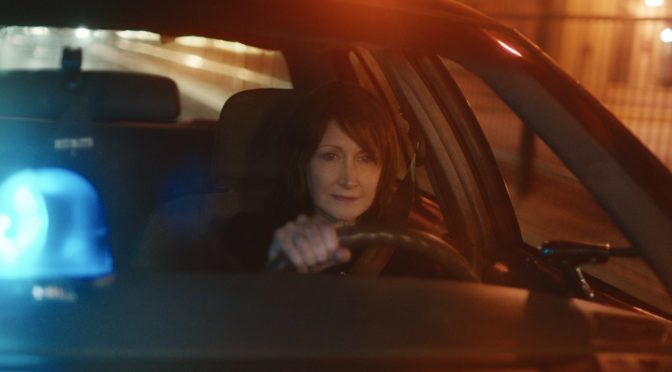 OUT OF BLUE, directed by Carol Morley, is simultaneously intriguing and frustrating. Morley has an interest in memory and repressed trauma, explored through the story of protagonist Detective Mike Hoolihan (Patricia Clarkson) and her dark and distant past. Using fragmented flashbacks, OUT OF BLUE is mystifying, unravelling a trail of red herrings towards a too-good-to-be-true ending.
OUT OF BLUE, directed by Carol Morley, is simultaneously intriguing and frustrating. Morley has an interest in memory and repressed trauma, explored through the story of protagonist Detective Mike Hoolihan (Patricia Clarkson) and her dark and distant past. Using fragmented flashbacks, OUT OF BLUE is mystifying, unravelling a trail of red herrings towards a too-good-to-be-true ending.
Set in New Orleans, the shock death of astronomy expert Dr Jennifer Rockwell (Mamie Gummer) sets Detective Hoolihan on a mission to uncover Jennifer’s killer and following, coincidentally, a trail of discovery about her own past. From the outset, Hoolihan is convinced that there have been issues in Jennifer’s family life, and when this proves to be true, after numerous twists and turns, it comes as little surprise as well as anti-climactic.
Clarkson is the definite stand out of this film. She is a refreshingly nuanced female lead whose performance carries OUT OF BLUE, with dramatic shots of her driving around the city being surprising highlights of the film. Other characters in the film, including the suspects Dr Ian Strammi (Toby Jones), Jennifer’s boss, and her boyfriend Duncan Reynolds (Jonathan Majors) risk playing stereotypes and lack any real depth. Their characterisation would see them better suited to a melodrama television-film on the small screen.
As a piece of art, you can appreciate what OUT OF BLUE is attempting, but it doesn’t quite hit its mark. It feels more like an artsy episode of CSI than a feature length film. The film would make for excellent Sunday afternoon viewing, though in a cinema context it felt a little dragged out.
OUT OF BLUE is much like a game of Cluedo; an extended search for whodunnit, an idea reinforced by the killer colonel and the stereotyped characters. The ending is convoluted and stretched; clues fall too fast and too easy into the path of Detective Hoolihan, and they are often more disorientating than enticing. Hoolihan’s connection to the case runs deeper than would be considered believable and repeated images such as Jennifer’s scarf and dripping blood in blonde hair, detract from the overall narrative. There is a suggestion of supernatural involvement, reinforced by the character’s interest in space, the opening scene of space and Hoolihan’s fear of the dark, but the ending is rooted in the mortal, and is therefore quite disappointing.
In the end, the narrative threads tie up too nicely and takes coincidence to a new level. Flashbacks are interestingly integrated in the narrative but while too much is explained in some parts, not enough is explained in others (such as the background of a reporter who frequently appears at the right moment).
OUT OF BLUE starts out better than it ends. It is too reliant on gimmicks and coincidence to provide a satisfactory ending. There are moments of real emotion and atmosphere, especially in scenes where Hoolihan is alone. There is also a diverse cast, with a range of voices to be heard, authentically reflecting its New Orleans setting.
When Hoolihan does face reality, the predictable ending is jarring and inadequate, and the film requires the audience to hope that there will be a satisfactory ending. OUT OF BLUE ends up a little bit lost in the cosmos, with an audience left in a disappointing and gaping black hole.

